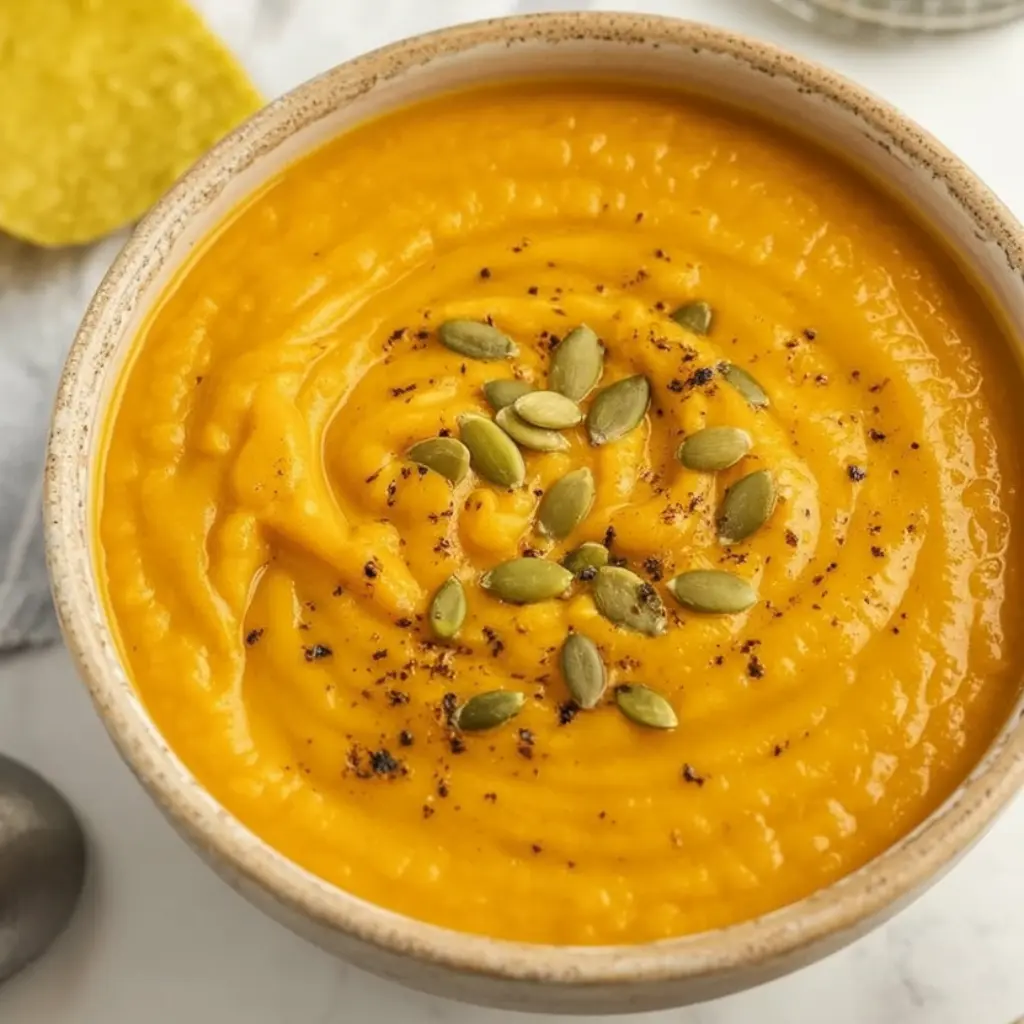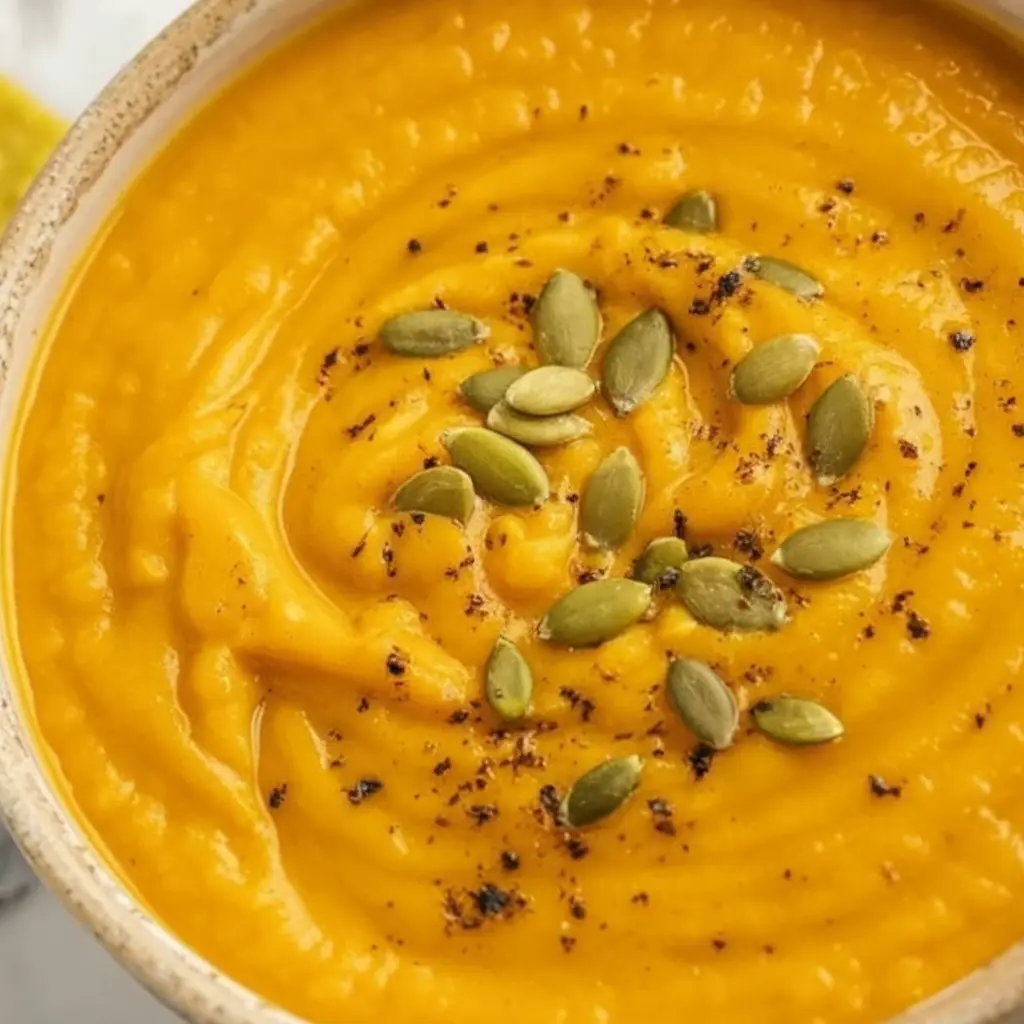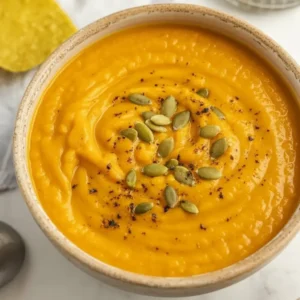The first time I made pumpkin soup, I was nineteen and just learning to cook for myself. It was October in my tiny apartment with drafty windows, and I remember standing in that small kitchen with a dented pot and a can of pumpkin I wasn’t entirely sure what to do with. I had grown up with pumpkin pie as a holiday staple, but soup? That felt unfamiliar and—if I’m honest—a little intimidating. I tossed together pumpkin purée, some broth, and a splash of cream, but it came out flat, almost bland. I sat at my wobbly table eating it with a slice of buttered toast, promising myself that one day I’d figure out how to make it taste as comforting as it should. Over the years, I’ve done just that. Today, my pumpkin soup is one of the dishes my family asks for as soon as the air turns crisp. It’s silky, warming, and somehow both simple and special. This is the recipe I now trust completely, one that feels like an old friend.

Why You’ll Love This Recipe
- Easy to make with simple pantry staples
- Creamy, comforting texture without being too heavy
- Budget-friendly and family-approved
- Perfect for make-ahead meals and leftovers
- Adaptable to different spices and substitutions
Ingredients You’ll Need
- Pumpkin: You can use canned pumpkin purée for convenience, which I often do, especially on busy weekdays. If you’re roasting your own, sugar pumpkins (sometimes called pie pumpkins) are your best bet—they’re sweeter and less watery than carving pumpkins.
- Onion: A yellow onion gives just the right amount of sweetness once softened. Don’t skip cooking it slowly; it builds the foundation of flavor.
- Garlic: Two cloves is my standard, but if you’re like my sister who believes garlic is its own food group, feel free to add more.
- Carrots: These bring a natural sweetness that balances the earthy pumpkin. I started adding them after running short on pumpkin one year, and now I never leave them out.
- Vegetable or chicken broth: Either works. I use homemade broth when I have it, but store-bought is fine. If you choose low-sodium, you’ll have more control over the seasoning.
- Cream: Just a splash of heavy cream (or half-and-half) at the end makes the soup velvety. Coconut milk works beautifully too and adds a gentle sweetness.
- Spices: A mix of ground nutmeg, cinnamon, and a little cayenne for warmth. Don’t worry, the cayenne doesn’t make it spicy—just gives a gentle heat at the back of the throat.
- Olive oil or butter: For sautéing. Butter brings richness, olive oil keeps it a little lighter. I often use half and half.
- Salt and pepper: Seasoning in layers makes all the difference, so add a pinch as you go rather than waiting until the end.
How to Make It (Step-by-Step Instructions)
Start by warming a tablespoon of olive oil or butter in a large pot. I’ve made the mistake before of rushing this step, tossing in the onions before the fat was hot, and they ended up steaming instead of caramelizing. Let the pot heat properly—it’s worth the extra minute.
Add the chopped onion and carrots, stirring occasionally until they’re soft and starting to turn golden. This takes about 8–10 minutes. Don’t be tempted to hurry; this is where the soup builds its flavor base. Garlic goes in next, and I cook it for just a minute until fragrant. Any longer, and it can turn bitter.
Now stir in your pumpkin purée along with the spices. Let them toast briefly with the vegetables—this trick wakes up the nutmeg and cinnamon so the soup doesn’t taste flat later. Then pour in the broth, stirring to scrape up any browned bits at the bottom of the pot.
Bring everything to a gentle simmer and let it cook uncovered for about 20 minutes. The carrots will soften fully, and the flavors will meld together. I always give it a taste at this point and adjust the seasoning, because once you blend, it’s harder to correct.
Turn off the heat and carefully blend the soup until silky smooth. I use an immersion blender right in the pot (less mess), but a regular blender works too—just do it in batches and be mindful of the steam.
Once blended, stir in the cream or coconut milk. Taste again and adjust with salt and pepper. If it feels too thick, a splash of extra broth or even water will loosen it without changing the flavor.
At this stage, I usually ladle out a small bowl for myself, because nothing beats that first taste with a slice of crusty bread.

Expert Tips for the Best Results
Pumpkin soup is forgiving, but the difference between a good bowl and a truly memorable one comes down to patience and balance. Don’t rush the onions and carrots—they’re the backbone of flavor. Toasting the spices briefly with the pumpkin keeps the soup from tasting one-note. And season in layers, tasting along the way, instead of waiting until the very end. I’ve also learned not to skimp on blending; the smoother the texture, the more luxurious the soup feels, even if you didn’t use much cream.
Variations & Substitutions
Over the years I’ve tried plenty of variations, some out of creativity and others out of necessity. When I was out of cream once, I used coconut milk and loved the faintly tropical twist—it’s now one of my favorite ways to make it. A friend swears by adding a spoonful of peanut butter for depth, and though I was skeptical at first, it turned out nutty and rich in a way I didn’t expect. I’ve also swapped carrots for sweet potatoes when that’s what I had on hand, and the soup turned out even silkier. If you like more spice, a touch of curry powder or smoked paprika changes the personality of the soup entirely, but still keeps it cozy and inviting.
Serving Suggestions
Pumpkin soup feels at home on both casual and elegant tables. I often serve it on weeknights with nothing more than a loaf of warm bread and a green salad, but I’ve also ladled it into small bowls as a starter for Thanksgiving dinner. It pairs beautifully with sharp cheeses, roasted chicken, or even a simple grilled cheese sandwich when comfort is the priority. Sometimes I top each bowl with a swirl of cream or a sprinkle of toasted pumpkin seeds, not for show, but because those little touches make it feel complete.
Storage & Reheating Instructions
This soup stores beautifully, which is one reason I make it so often. I let it cool completely before transferring it to airtight containers, and it keeps in the refrigerator for up to four days. The flavors actually deepen after a night’s rest. For longer storage, it freezes well—just leave out the cream until you reheat, as dairy can sometimes separate. To reheat, I warm it gently on the stovetop over medium heat, stirring occasionally. If it thickens in the fridge, a splash of broth or water brings it right back to the perfect consistency.
Recipe FAQs (Answered by Clara)
Can I make this ahead of time?
You sure can. I often prepare it in the morning, cover it tightly, and pop it in the fridge. It actually tastes better after resting.
What if I don’t have an immersion blender?
No problem. Just ladle it into a regular blender in batches, making sure to vent the lid slightly to let steam escape.
Can I use pumpkin pie filling instead of purée?
I wouldn’t recommend it. Pumpkin pie filling has sugar and spices already mixed in, and it will throw off the flavor of the soup. Stick to plain pumpkin purée.
How do I make it vegan?
Easy—use vegetable broth and coconut milk instead of cream. It’s naturally rich and just as satisfying.

Conclusion
Pumpkin soup has come a long way for me—from that disappointing first attempt to the version I now make with confidence and pride. I love that it’s simple enough for a weeknight, yet comforting enough to feel like a small celebration every time it’s served. If you’ve never made it before, I hope this recipe feels like a gentle nudge to give it a try. And if you have, maybe you’ll find a new twist or technique here to make it even better. I’d love to hear how it turns out in your kitchen—share your version, ask a question, or just enjoy the quiet joy of a warm bowl of soup.
Nutrition Information (per serving, approx. 1 cup)
- Calories: 180
- Fat: 9g
- Carbohydrates: 22g
- Fiber: 5g
- Protein: 3g
- Sodium: 540mg

Pumpkin Soup
Ingredients
- 2 tbsp olive oil or butter
- 1 medium onion chopped
- 2 cloves garlic minced
- 3 cups pumpkin purée fresh or canned
- 3 cups vegetable broth or chicken broth
- 1 cup heavy cream or coconut milk for dairy-free
- 1 tsp ground cinnamon
- ¼ tsp nutmeg
- Salt and black pepper to taste
- Fresh parsley or pumpkin seeds for garnish
Instructions
- Sauté aromatics: Heat olive oil in a large pot over medium heat. Add onion and cook until soft, about 5 minutes. Stir in garlic and cook another minute.
- Add pumpkin & broth: Stir in pumpkin purée and broth. Bring to a simmer and cook for 15 minutes.
- Blend: Use an immersion blender (or transfer to a blender in batches) to puree soup until smooth and creamy.
- Season & finish: Stir in cream, cinnamon, nutmeg, salt, and pepper. Simmer gently for 5 more minutes.
- Serve: Ladle into bowls and garnish with parsley, pumpkin seeds, or a swirl of cream.
Notes
- For a spicier version, add a pinch of cayenne or curry powder.
- To make vegan, swap butter for olive oil and use coconut milk instead of cream.
- Store leftovers in the fridge for up to 4 days or freeze for up to 2 months.
- Serve alongside grilled cheese or warm bread for a hearty meal.

